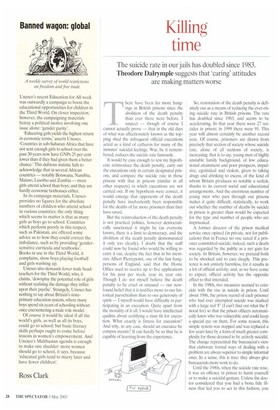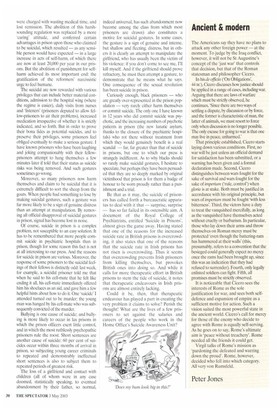Killing time
The suicide rate in our jails has doubled since 1983. Theodore Dalrymple suggests that 'caring' attitudes are making matters worse There have been far more hangings in British prisons since the abolition of the death penalty than ever there were before. I suspect — though of course I cannot actually prove — that in the old days of what was affectionately known as the topping shed the infrequent official executions acted as a kind of catharsis for many of the inmates' suicidal feelings. War, be it remembered, reduces the suicide rate famously.
It would be easy enough to test my hypothesis: reintroduce the death penalty, carry out the executions only in certain designated prisons, and compare the suicide rate in those prisons with that in prisons (similar in all other respects) in which executions are not carried out. If my hypothesis were correct, it would emerge that opponents of the death penalty have inadvertently been responsible for the deaths of far more prisoners than they have saved.
But the reintroduction of the death penalty is not practical politics, however democratically sanctioned it might be (as everyone knows, there is a limit to democracy, and the abolition of the death penalty demonstrated it only too clearly). I doubt that the staff could now be found who would he willing to carry it out, despite the fact that in his memoirs Albert Pierrepoint, one of the last hangpersons of England, said that the Home Office used to receive up to five applications for his post per week, year in, year out. Though I do not myself believe the death penalty to be cruel or unusual — our newfound belief that it is testifies more to our historical parochialism than to our generosity of spirit — I myself would have difficulty in participating in an execution. Quite apart from the morality of it all, I would have intellectual qualms about certifying a man fit for execution. What exactly is fitness for execution? And why, in any case, should an executee be compos mentis? It can hardly be so that he is capable of learning from the experience. So, restoration of the death penalty is definitely out as a means of reducing the ever-rising suicide rate in British prisons. The rate has doubled since 1983, and seems to be accelerating. In that year there were 27 suicides in prison; in 1999 there were 91. This year will almost certainly be another record year. Of course, prisoners are drawn from precisely that section of society whose suicide rate, alone of all sections of society, is increasing; that is to say, young men of highly unstable family background, of low educational attainment and poor prospects, impulsive, egotistical and violent, given to taking drugs and drinking to excess, of the kind of whom Britain produces so notable a surfeit, thanks to its current social and educational arrangements. And the enormous number of young men who pass through our prisons makes it quite difficult, statistically, to work out whether the number of deaths by suicide in prison is greater than would be expected for the type and number of people who are imprisoned.
A former director of the prison medical service once opined (in private, not for publication) that in France no one cared if a prisoner committed suicide; indeed, such a death was regarded by the public as a net gain for society. In Britain, however, we pretend both to be shocked and to care deeply. This pretence is not entirely harmless, for it results in a lot of official activity; and, as we have come to expect, official activity has the opposite effect to that intended.
In the 1980s, two measures seemed to coincide with the rise in suicide in prison. Until about 1986, the prison record of each prisoner who had ever attempted suicide was marked with a large red 'F' (I can't find out what the F stood for) so that the prison officers automatically knew who was vulnerable and could keep a special eye on them. For some reason, this simple system was stopped and was replaced a few years later by a form of much greater complexity for those deemed to be actively suicidal. The change represented the bureaucrat's view that elaborate formal ways of dealing with a problem are always superior to simple informal ones. In a sense, this is true: they always give bureaucrats more work to do.
Until the 1980s, when the suicide rate rose, it was an offence in prison to harm yourself or to make a suicidal gesture. Unless the doctor considered that you had a bona fide illness that led you to act in this fashion, you were charged with wasting medical time, and lost remission. The abolition of this harshsounding regulation was replaced by a more 'caring attitude, and conferred certain advantages in prison upon those who claimed to be suicidal, which resulted — as any sensible person would have expected — in a large increase in acts of self-harm, of which there are now at least 20,000 per year in our prisons. But the abolition of punishment for selfharm achieved its most important end: the gratification of the reformers' narcissistic urge to feel humane.
The suicidal are now rewarded with various privileges that can include better material conditions, admission to the hospital wing (where the regime is easier). daily visits from nurses and 'listeners' (prisoners deputed to allow fellow-prisoners to air their problems), increased medication irrespective of whether it is strictly indicated, and so forth. But in order to prove their bona fides as potential suicides, and to preserve their privileges, some prisoners feel obliged eventually to make a serious gesture. I have known prisoners who have been laughing and joking companionably with their fellowprisoners attempt to hang themselves a few minutes later if told that their status as suicide risks was being removed. And such gestures sometimes go wrong.
Moreover, so many prisoners now harm themselves and claim to be suicidal that it is extremely difficult to sort the sheep from the goats. When people had something to lose by making suicidal gestures, such a gesture was far more likely to be a sign of genuine distress than an attempt at manipulation. By removing all official disapproval of suicidal gestures in prison, signal has become lost in noise.
Of course, suicide in prison is a complex problem, not susceptible to an easy solution. It has to be remembered that more people commit suicide in psychiatric hospitals than in prison, though for some reason this fact is not at all interesting to our press. And the reasons for suicide in prison are various. Moreover, the response of some prisoners to the suicidal feelings of their fellow's is distinctly odd: last week, for example, a suicidal prisoner told me that when he said to his cell-mate that he felt like ending it all, his cell-mate immediately offered him his shoelaces as an aid, and gave him a few helpful hints about how to do it. One 'suicide' I attended turned out to be murder: the young man was banged by his cell-mate who was subsequently convicted of the murder.
Bullying is one cause of suicide; and bullying is more likely to occur in lax prisons in which the prison officers exert little control, and in which the most ruthlessly psychopathic prisoners rule the roost. Short sentences are another cause of suicide: 60 per cent of suicides occur within three months of arrival in prison, so subjecting young career criminals to repeated and demonstrably ineffectual short sentences is also to subject them to repeated periods of greatest risk.
The loss of a girlfriend and contact with children (all of whom were in any case doomed, statistically speaking, to eventual abandonment by their father, so normal, indeed universal, has such abandonment now become among the class from which most prisoners are drawn) also constitutes a motive for suicidal gestures. In some cases, the gesture is a sign of genuine and intense, but shallow and fleeting, distress, but in others it is clearly an attempt to manipulate the girlfriend, who has usually been the victim of his violence: if you don't come to see me, I'll kill myself. And if the girlfriend should prove refractory, he must then attempt a gesture, to demonstrate that he means what he says. One consequence of the sexual revolution has been suicide in prison.
Curiously enough, black prisoners — who are greatly over-represented in the prison population — very rarely either harm themselves or commit suicide. The only one I have known in 12 years who did commit suicide was psychotic, and the increasing numbers of psychotic patients in prison (the new lunatic asylum, thanks to the closure of the psychiatric hospitals) who rot there without treatment from which they would genuinely benefit is a real scandal — far, far greater than that of suicide in prisons, but one to which our press is strangely indifferent. As to why blacks should so rarely make suicidal gestures, I hesitate to speculate, but perhaps they have been persuaded that they are so deeply marked by original victimhood that prison is for them a badge of honour to be worn proudly rather than a punishment and a trial.
Be that as it may, the suicide of prisoners has called forth a bureaucratic apparatus to deal with it that — surprise, surprise — has so far failed in its ostensible aim. A document of the Royal College of Psychiatrists, entitled 'Suicide in Prisons', almost gives the game away. Having stated that one of the reasons for the increased suicide rate in British prisons is overcrowding, it also states that one of the reasons that the suicide rate in Irish prisons has not risen is overcrowding. Thus it seems that overcrowding prevents Irish prisoners from killing themselves, but provokes British ones into doing so. And while it calls for more therapeutic effort in British prisons to stem the tide of suicide, it notes that therapeutic endeavours in Irish prisons are almost entirely lacking.
Could it be, then, that therapeutic endeavour has played a part in creating the very problem it claims to solve? Perish the thought! What are the lives of a few prisoners to set against the salaries and careers of the people who work in the Home Office's Suicide Awareness Unit?











































































 Previous page
Previous page